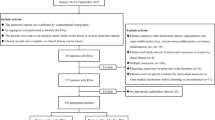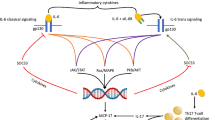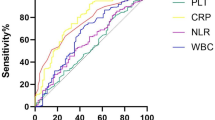Abstract
Serum interleukin-1 (IL-1) are possibly indicative of the inflammation in the intracranial aneurysm (IA) wall. This study aimed to investigate whether IL-1 could discriminate the unstable IAs (ruptured intracranial aneurysms (RIAs) and symptomatic unruptured intracranial aneurysms (UIAs)) from stable, asymptomatic UIAs. IA tissues and blood samples from 35 RIA patients and 35 UIA patients were collected between January 2017 and June 2020 as the derivation cohort. Blood samples from 211 patients with UIAs were collected between January 2021 and June 2022 as the validation cohort (including 63 symptomatic UIAs). Blood samples from 35 non-cerebral-edema meningioma patients (non-inflammatory control) and 19 patients with unknown-cause subarachnoid hemorrhage (hemorrhagic control) were also collected. IL-1β and IL-1.ra (IL-1 receptor antagonist) were measured in serum and IA tissues, and the IL-1 ratio was calculated as log10 (IL-1.ra/IL-1β). Based on the derivation cohort, multivariate logistic analysis showed that IL-1β (odds ratio, 1.48, P = 0.001) and IL-1.ra (odds ratio, 0.74, P = 0.005) were associated with RIAs. The IL-1 ratio showed an excellent diagnostic accuracy for RIAs (c-statistic, 0.91). Histological analysis confirmed the significant correlation of IL-1 between serum and aneurysm tissues. IL-1 ratio could discriminate UIAs from non-inflammatory controls (c-statistic, 0.84), and RIAs from hemorrhagic controls (c-statistic, 0.95). Based on the validation cohort, the combination of IL-1 ratio and PHASES score had better diagnostic accuracy for symptomatic UIAs than PHASES score alone (c-statistic, 0.88 vs 0.80, P < 0.001). Serum IL-1 levels correlate with aneurysm tissue IL-1 levels and unstable aneurysm status, and could serve as a potential biomarker for IA instability.






Similar content being viewed by others
Data Availability
The datasets generated and/or analyzed during the current study are not publicly available due to ethical requirement but are available from the corresponding author on reasonable request.
Abbreviations
- IA:
-
Intracranial aneurysm
- RIA:
-
Ruptured intracranial aneurysm
- UIA:
-
Unruptured intracranial aneurysm
- GSDMD:
-
Gasdermin D
- IOD:
-
Integrated optical density
- ICA:
-
Internal carotid artery
- MCA:
-
Middle cerebral artery
- IL-1:
-
Interleukin 1
- IL-1β:
-
Interleukin 1 β
- IL-1.ra:
-
Interleukin 1 receptor antagonist
- CTA:
-
Computational tomographic angiography
- CT:
-
Computational tomography
- MRI:
-
Magnetic resonance image
References
Molenberg R, Aalbers MW, Appelman APA, Uyttenboogaart M, van Dijk JMC. Intracranial aneurysm wall enhancement as an indicator of instability: a systematic review and meta-analysis. Eur J Neurol. 2021;28:3837–48.
Vergouwen MDI, Backes D, van der Schaaf IC, Hendrikse J, Kleinloog R, Algra A, et al. Gadolinium enhancement of the aneurysm wall in unruptured intracranial aneurysms is associated with an increased risk of aneurysm instability: a follow-up study. AJNR Am J Neuroradiol. 2019;40:1112–6.
Frosen J, Tulamo R, Paetau A, Laaksamo E, Korja M, Laakso A, et al. Saccular intracranial aneurysm: pathology and mechanisms. Acta Neuropathol. 2012;123:773–86.
Dinarello CA, Simon A, van der Meer JW. Treating inflammation by blocking interleukin-1 in a broad spectrum of diseases. Nat Rev Drug Discov. 2012;11:633–52.
Mai W, Liao Y. Targeting il-1beta in the treatment of atherosclerosis. Front Immunol. 2020;11:589654.
Moriwaki T, Takagi Y, Sadamasa N, Aoki T, Nozaki K, Hashimoto N. Impaired progression of cerebral aneurysms in interleukin-1beta-deficient mice. Stroke. 2006;37:900–5.
Ryder CB, Kondolf HC, O'Keefe ME, Zhou B, Abbott DW. Chemical modulation of gasdermin-mediated pyroptosis and therapeutic potential. J Mol Biol. 2021;434:167183.
Liu Q, Zhang Y, Zhu C, Liu W, Ma X, Chen J, et al. Serum il-1, pyroptosis and intracranial aneurysm wall enhancement: analysis integrating radiology, serum cytokines and histology. Front Cardiovasc Med. 2022;9:818789.
Dinger TF, Darkwah Oppong M, Park C, Said M, Chihi M, Rauschenbach L, et al. Development of multiple intracranial aneurysms: beyond the common risk factors. J Neurosurg. 2022;137:1056–63.
Moro JA, Carretero J, Alonso MI, Martin C, Gato A, Mano AL. Prenatal expression of interleukin 1beta and interleukin 6 in the rat pituitary gland. Cytokine. 2008;44:315–22.
Wang B, Cui Z, Zhong Z, Sun Y, Yang GY, Sun Q, et al. The role and regulatory mechanism of il-1beta on the methylation of the nf2 gene in benign meningiomas and leptomeninges. Mol Carcinog. 2016;55:2268–77.
Barak T, Ristori E, Ercan-Sencicek AG, Miyagishima DF, Nelson-Williams C, Dong W, et al. Ppil4 is essential for brain angiogenesis and implicated in intracranial aneurysms in humans. Nat Med. 2021;27:2165–75.
Brinjikji W, Zhu YQ, Lanzino G, Cloft HJ, Murad MH, Wang Z, et al. Risk factors for growth of intracranial aneurysms: a systematic review and meta-analysis. AJNR Am J Neuroradiol. 2016;37:615–20.
Greving JP, Wermer MJ, Brown RD Jr, Morita A, Juvela S, Yonekura M, et al. Development of the phases score for prediction of risk of rupture of intracranial aneurysms: a pooled analysis of six prospective cohort studies. Lancet Neurol. 2014;13:59–66.
Backes D, Rinkel GJE, Greving JP, Velthuis BK, Murayama Y, Takao H, et al. Elapss score for prediction of risk of growth of unruptured intracranial aneurysms. Neurology. 2017;88:1600–6.
Kleinloog R, de Mul N, Verweij BH, Post JA, Rinkel GJE, Ruigrok YM. Risk factors for intracranial aneurysm rupture: a systematic review. Neurosurgery. 2018;82:431–40.
Gilard V, Grangeon L, Guegan-Massardier E, Sallansonnet-Froment M, Maltete D, Derrey S, et al. Headache changes prior to aneurysmal rupture: a symptom of unruptured aneurysm? Neurochirurgie. 2016;62:241–4.
Yanaka K, Matsumaru Y, Mashiko R, Hyodo A, Sugimoto K, Nose T. Small unruptured cerebral aneurysms presenting with oculomotor nerve palsy. Neurosurgery. 2003;52:553–7.
Cianfoni A, Pravata E, De Blasi R, Tschuor CS, Bonaldi G. Clinical presentation of cerebral aneurysms. Eur J Radiol. 2013;82:1618–22.
Liu Q, Zhang Y, Yang J et al. The relationship of morphological-hemodynamic characteristics, inflammation, and remodeling of aneurysm wall in unruptured intracranial aneurysms.[J]. Transl Stroke Res. 2022;13:88–99.
Frosen J, Piippo A, Paetau A, Kangasniemi M, Niemela M, Hernesniemi J, et al. Remodeling of saccular cerebral artery aneurysm wall is associated with rupture: histological analysis of 24 unruptured and 42 ruptured cases. Stroke. 2004;35:2287–93.
Liu Q, Leng X, Yang J, Yang Y, Jiang P, Li M, et al. Stability of unruptured intracranial aneurysms in the anterior circulation: nomogram models for risk assessment. J Neurosurg. 2022;137:675–84.
Meng H, Tutino VM, Xiang J, Siddiqui A. High wss or low wss? Complex interactions of hemodynamics with intracranial aneurysm initiation, growth, and rupture: toward a unifying hypothesis. AJNR Am J Neuroradiol. 2014;35:1254–62.
Funding
This study was supported by the “National Natural Science Foundation of China (Grant No. 82071296),” “National Key Research and Development Program of the 14th Five-Year Plan (Grant No. 2021YFC2501100),” “Top Talent Support Program for young and middle-aged people of Wuxi Health Committee (Grant No.202014)” and “TAIHU Top Talent Support Program for Top Medical Experts (Grant No. TH202109).”
Author information
Authors and Affiliations
Contributions
Author contributions to the study and manuscript preparation include the following. Conception and design: QY. Liu and P. Liu. Acquisition of data: QY. Liu, P. Liu, YS. Zhang, and JA. Li. Analysis and interpretation of data: QY. Liu and CC. Zhu. Drafting the article: QY. Liu. Critically revising the article: Mahmud. MB, David H, CC. Zhu, and S. Wang. Approving the final version of the manuscript on behalf of all authors: S. Wang. Study supervision: S. Wang.
Corresponding authors
Ethics declarations
Ethics Approval and Consent to Participate
This study was approved by institutional ethics committees (KY2017-076-01). All patients (or guardians of patients) provided written informed consents.
Consent for Publication
Not applicable.
Conflict of Interest
The authors declare no competing interests.
Additional information
Publisher’s Note
Springer Nature remains neutral with regard to jurisdictional claims in published maps and institutional affiliations.
Supplementary Information
Supplementary materials 1:
Supplemental Figure 1. Establishment of the derivation cohort. Supplemental Figure 2. Establishment of the validation cohort. Supplemental Figure 3. The representative cases of aneurysm wall remodeling. Supplemental Figure 4. The measurement of atherosclerosis area. Supplemental Figure 5. The back-to-back histograms presented the propensity score between pre- and post-PSM. Supplemental Figure 6. The correlation of IL-1 between serum and aneurysm samples. Supplemental Figure 7. Subgroup analysis to identify the correlation of IL-1 between serum and aneurysm samples. Supplemental Figure 8. The modified Fisher scaler between patients with RIAs and patients in hemorrhagic control. Supplemental Table 1. The reagents in this study. Supplemental Table 2. The propensity score between pre- and post-PSM within the derivation cohort. Supplemental Table 3. Inter-observer agreement analyses. Supplemental Table 4. The serum cytokines of RIA patients and UIA patients. Supplemental Table 5. The logistics regression for the serum cytokines associated with ruptured intracranial aneurysm. Supplemental Table 6. The comparison of characteristics among the derivation cohort, healthy control and hemorrhagic control. Supplemental Table 8. The characteristics of patients in the validation cohort. Supplemental Table 9. The univariate logistic analysis for factors associated with symptomatic UIAs. Supplemental Table 10. The multivariate logistics regression for factors associated with symptomatic UIAs.
Rights and permissions
Springer Nature or its licensor (e.g. a society or other partner) holds exclusive rights to this article under a publishing agreement with the author(s) or other rightsholder(s); author self-archiving of the accepted manuscript version of this article is solely governed by the terms of such publishing agreement and applicable law.
About this article
Cite this article
Liu, Q., Liu, P., Zhang, Y. et al. Serum Interleukin-1 Levels Are Associated with Intracranial Aneurysm Instability. Transl. Stroke Res. 15, 433–445 (2024). https://doi.org/10.1007/s12975-023-01140-w
Received:
Revised:
Accepted:
Published:
Issue Date:
DOI: https://doi.org/10.1007/s12975-023-01140-w




